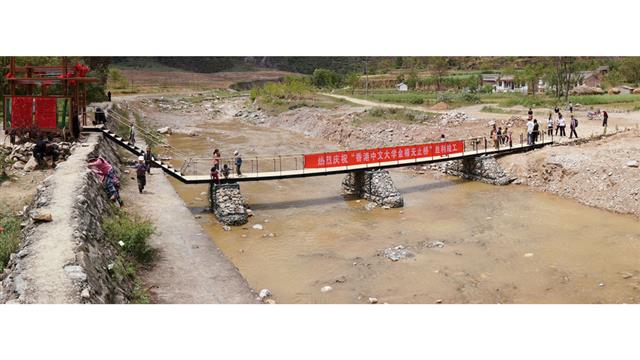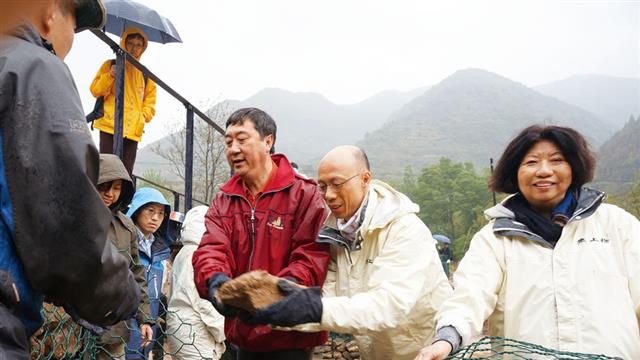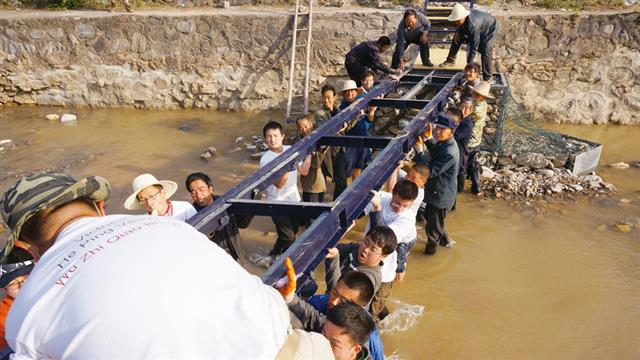This is a bridge located in a remote mountainous area in Northwest China. It spans Mayan River, unheard of for most Hong Kong people. It flows through Dangzheng Village, a small and remote village in Hui County, Longnan City, Gansu Province. From 30 April to 7 May, CUHK volunteers from the School of Architecture and the Jockey Club School of Public Health and Primary Care went to Dangzheng Village with their counterparts from Peking University, Xi’an Jiaotong University, Stanford University and Oxford University to build a bridge for villagers. Initiated by Prof. Edward Ng from the School of Architecture, this bridge building project is named the ‘CUHK Golden Jubilee Wu Zhi Qiao’ to celebrate the University’s 50th anniversary.
The villagers of Dangzheng Village live on the banks of Mayan River. Some of their children have to cross the river every day to go to school. The log bridge they used was shaky and was washed away by heavy river flow during the rainy season.
The volunteers from the five universities arrived at the village on 30 April to build a permanent footbridge for the villagers. They were divided into the construction team, the logistics team and the community services team. In addition to building a bridge, they taught health-related knowledge at a local school, did simple physical check-ups for the villagers, sent disaster supply kits to the villagers and promoted disaster preparedness among them.
At noon on 4 May, several new members arrived at Dangzheng Village to join the volunteers. They included Ms. Leonie Ki, honorary secretary of the Wu Zhi Qiao (Bridge to China) Charitable Foundation; Ms. Sharon Chow, chief executive officer of the foundation; Mr. Felix Lo, representative of Dr. Chan Sui-kau and his family who sponsored this bridge building project; Prof. Emily Chan, director of the Collaborating Centre for Oxford University and CUHK for Disaster and Medical Humanitarian Response. One of the new comers was Professor Ng’s old friend who took part in the first Wu Zhi Qiao project in 2005. He was Mr. Wong Kam-sing, the current Secretary for the Environment of the HKSAR. Mr. Wong said, ‘This bridge is built to commemorate CUHK’s 50th anniversary. So I’m here to show my support.’
On the morning of 5 May shortly after breakfast, Prof. Joseph J.Y. Sung, CUHK Vice-Chancellor, and Prof. Sian Griffiths, director of the Centre for Global Health, CUHK, also arrived at the village. Together with Mr. Wong Kam-sing, they put rocks into the gabions that were used as piers of the bridge. Mr. Wong was no stranger to the task. Making gabion piers with hooks and wire for the first time, Professor Sung joked, ‘It’s not difficult at all, just like performing surgery.’
After toiling under the scorching sun and in the intermittent rain for a week, the volunteers finished building the bridge which was officially opened on 7 May.
It is a fascinating fate that the bridge commemorating the golden jubilee of CUHK was built in a small village located 1,600 km from Hong Kong. On the last evening, the local children asked the volunteers to write farewell messages. One wrote: ‘Perhaps there will be a day when you’ll leave this village for studies at CUHK.’ Connecting places and people—isn’t that what a bridge is for?





